Theoretical Economics Letters
Vol.3 No.2(2013), Article ID:30827,10 pages DOI:10.4236/tel.2013.32020
Capacity Choice in a Mixed Duopoly: The Relative Performance Approach*
1College of Economics, Nihon University, Tokyo, Japan
2Faculty of Economics and Business Administration, Reitaku University, Kashiwa, Japan
Email: #yasuhiko.r.nakamura@gmail.com
Copyright © 2013 Yasuhiko Nakamura, Masayuki Saito. This is an open access article distributed under the Creative Commons Attribution License, which permits unrestricted use, distribution, and reproduction in any medium, provided the original work is properly cited.
Received February 9, 2013; revised March 8, 2013; accepted April 8, 2013
Keywords: Mixed Duopoly; Relative Profit; Degree of Importance of the Relative Performance
ABSTRACT
This paper studies capacity choice in a quantity-setting mixed duopoly with differentiated goods, when the objective function of the private firm is its relative profit. In this paper, we show that the differences between the output levels and capacity levels between both the public firm and the private firm strictly depend on both the degrees of product differentiation and of importance of the private firm’s relative performance. More precisely, we find that the public firm chooses over-capacity when both the degrees of importance of the private firm’s relative performance and of product differentiation are sufficiently high whereas it chooses under-capacity otherwise, and further the private firm chooses under-capacity when the degree of importance of its relative performance is high as compared the degree of product differentiation whereas it chooses over-capacity otherwise.
1. Introduction
This paper reconsiders the capacity choices of a public firm that is a welfare-maximizer and a private firm that is a relative-profit-maximizer in the context of a mixed duopoly. In particular, we focus on the effect of the degree of importance of the private firm’s relative performance on the differences of both the public firm’s and the private firm’s output and capacity levels.
Many researchers have been considering capacity choice in a private oligopoly composed of only private firms since the works of Dixit [1] and Brander and Spencer [2].1 In contrast, in the context of mixed oligopoly, researches on the capacity choices of both the public firm and the private firm are relatively recent. Nishimori and Ogawa [7], as a pioneering paper in this field, considered capacity choice in a mixed duopoly with homogeneous goods, and subsequently in a mixed duopoly with differentiated goods. Ogawa [8] and BarcenaRuiz and Garzon [9] investigated capacity choice under quantity-setting competition and price-setting competition, respectively.2 Tomaru et al. [10] extended the capacity choice models of the above three papers by introducing the separation between ownership and management within each firm in the fashion of Fershtman and Judd [11], Sklivas [12], and Vickers [13] (the socalled FJSV managerial delegation), and they obtained the results that both firms select over-capacity irrespective of the relation of their products and their FJSV delegation parameters in quantity-setting competition, but select under-capacity irrespective of the relation of their products and their FJSV delegation parameters in pricesetting competition.3
In this paper, in a quantity-setting market with differentiated goods, we assume that the objective function of the private firm is its relative profit, that is, 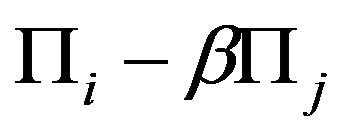 , where
, where 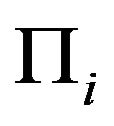 is its profit and
is its profit and  is the public firm’s profit, and
is the public firm’s profit, and .4 In particularly, we investigate the effect of both
.4 In particularly, we investigate the effect of both  and the degree of product differentiation on the differences between the output and capacity levels of both firms. The one of reasons why we consider the relative profit as the objective of the private firm is that evaluations of managerial performances are frequently based on not the absolute performance of managers on but their relative performance.5 In addition, the theoretical rationale such that the value of
and the degree of product differentiation on the differences between the output and capacity levels of both firms. The one of reasons why we consider the relative profit as the objective of the private firm is that evaluations of managerial performances are frequently based on not the absolute performance of managers on but their relative performance.5 In addition, the theoretical rationale such that the value of  is positive is composed of the following two facts: 1) The advantage of outperforming managers in the management job market; 2) The evolutionary stability and the spiteful behaviors of managers that is closely related to the objective functions based on their relative performance, which are indicated in the experimental works.6 Furthermore, in the real world mixed oligopolistic market in Japan, the idea of yardstick competition has been introduced as yardstick regulations in the industries including natural gas and rail in order for the authority to regulate the managerial efficiencies of all the public and private firms.7 Of course, under the yardstick competition, the private firm must pay attention to the profits of all the rival firms including the public firm. In such industries, it is likely that the objective function of the private firm is its relative profit. Additionally, in particular in developing countries, it is considered that the private firm envies the public firm which is overly protected by the corresponding authority or the government. Such a situation corresponds to the case such that the private firm has some sort of positive
is positive is composed of the following two facts: 1) The advantage of outperforming managers in the management job market; 2) The evolutionary stability and the spiteful behaviors of managers that is closely related to the objective functions based on their relative performance, which are indicated in the experimental works.6 Furthermore, in the real world mixed oligopolistic market in Japan, the idea of yardstick competition has been introduced as yardstick regulations in the industries including natural gas and rail in order for the authority to regulate the managerial efficiencies of all the public and private firms.7 Of course, under the yardstick competition, the private firm must pay attention to the profits of all the rival firms including the public firm. In such industries, it is likely that the objective function of the private firm is its relative profit. Additionally, in particular in developing countries, it is considered that the private firm envies the public firm which is overly protected by the corresponding authority or the government. Such a situation corresponds to the case such that the private firm has some sort of positive  in its relative profit.8
in its relative profit.8
| 7In Laffont and Tirole [29], such a yardstick competition is referred to as “relative performance evaluation”. Thus, the yardstick regulations in the industries including natural gas and rail are closely related to the relative profit approach which is adopted in this paper. 8See also Matsumura and Matsushima [19] for a detailed discussion on the rationales for firms’ objective functions based on relative performance. |
The purpose of this paper is to ascertain the effect of the degree of importance of the private firm’s relative performance on the difference between the output and capacity levels of both the firms. In this paper, we first show that the public firm chooses over-capacity when both the degrees of importance of the private firm’s relative performance and of product differentiation are sufficiently high, whereas it chooses under-capacity otherwise. The intuition behind the result on the difference between the output level and capacity level of the public firm obtained except for the case wherein both the degrees are sufficiently high is similar to that presented in Ogawa [8]. On the other hand, the intuition behind the result obtained in the case wherein both the degrees of importance of the private firm’s relative performance and of product differentiation are sufficiently high is given as follows. When the degree of product differentiation is sufficiently high, the degree of strategic substitutability between the outputs of both the public firm and the private firm is sufficiently strong, and hence the aggressive behavior of the public firm in the market leads to a sharply decrease of the output level of the private firm. In addition, when the degree of importance of the private firm’s relative performance is sufficiently high, the public firm is less likely to have an incentive to decrease its capacity level in order to induce the aggressive behavior of the private firm in the market. Based on the above influences of the sufficiently high values of the degrees of importance of the private firm’s relative performance and of product differentiation, the public firm strategically can choose over-capacity.
In addition, in this paper, it is also shown that the difference between the output and capacity levels of the private firm strictly depends on both the degree of importance of the private firm’s relative performance and the degree of product differentiation. More precisely, when the degree of importance of the private firm’s relative performance is high relative to the degree of product differentiation, the private firm aggressively behaves in the market, implying under-capacity by the private firm. Otherwise, that is, when the degree of importance of the private firm’s relative performance is low relative to the degree of product differentiation, the private firm strategically chooses over-capacity in order to increase its payoff by enlarging its market share because its capacity level is negatively associated with the output level of the public firm. The main contribution of this paper is that even if the relation between the products of the public firm and the private firm is restricted to substitutability, the differences between the output levels and capacity levels of both the public firm and the private firm can change according to the degree of importance of the private firm’s relative performance. Therefore, whether both the public firm and the private firm select undercapacity or over-capacity depends on not only the degree of product differentiation, which is shown in the existing literature in this field, but also on the degree of importance of the private firm’s relative performance.
The remainder of this paper is organized as follows. In Section 2, we formulate a quantity-setting mixed duopolistic model with differentiated goods with the capacity choices of both the public firm and the private firm that will be investigated throughout this paper. In Section 3, we consider the difference between the output and capacity levels of both firms using the model built in Section 2. Section 4 concludes with several remarks. The market outcomes including each firm’s equilibrium profit, the equilibrium consumer surplus, and the equilibrium social welfare are relegated to the Appendix.
2. Model
We formulate a quantity-setting mixed duopolistic model with choices of not only the output levels but also the capacity levels for both the public firm (firm 0) and the private firm (firm 1). The basic structure of the model follows a standard product differentiation model as in Singh and Vives [30]. Thus, firms 0 and 1 face the following inverse demand function: , where
, where  is the quantity of good
is the quantity of good  and
and  is its price
is its price .9 Note that
.9 Note that 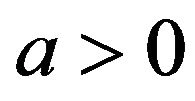 and
and 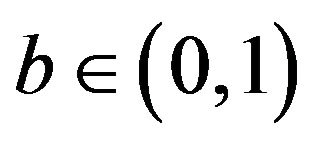 are demand parameters with
are demand parameters with  denoting the degree of product differentiation.10 This inverse demand system can be described from a quasi-linear representative consumer utility function of the form
denoting the degree of product differentiation.10 This inverse demand system can be described from a quasi-linear representative consumer utility function of the form

where  represents the numeraire goods.
represents the numeraire goods.
Let 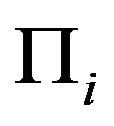 be firm
be firm ’s profit and let
’s profit and let  be firm
be firm ’s relative profit
’s relative profit . Then, in particular, the payoff of firm 1 is given by
. Then, in particular, the payoff of firm 1 is given by  whereas the payoff of firm 0 is given by
whereas the payoff of firm 0 is given by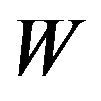 , where
, where  is the total social surplus (the sum of consumer surplus and the profits of firms 0 and 1).11 Moreover, we assume that
is the total social surplus (the sum of consumer surplus and the profits of firms 0 and 1).11 Moreover, we assume that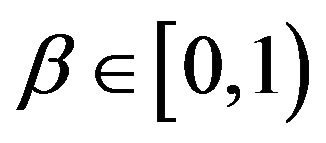 .12 The parameter
.12 The parameter  indicates the degree of importance of the relative performance of the private firm, firm 1.
indicates the degree of importance of the relative performance of the private firm, firm 1.
Both firms adopt identical technologies represented by the cost function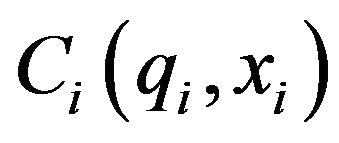 , where
, where  is the capacity level of firm
is the capacity level of firm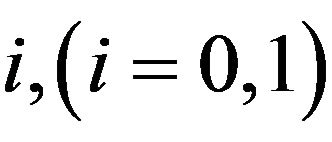 . Following Vives [33], Ogawa [8], Barcena-Ruiz and Garzon [9], and Tomaru et al. [10], we assume that the cost function is given by
. Following Vives [33], Ogawa [8], Barcena-Ruiz and Garzon [9], and Tomaru et al. [10], we assume that the cost function is given by
 . This cost function implies that if each firm’s output level equals its capacity level,
. This cost function implies that if each firm’s output level equals its capacity level, 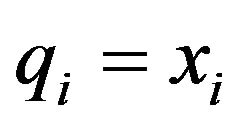 , the long-run average cost is minimized. The profit of firm
, the long-run average cost is minimized. The profit of firm  is given by
is given by
 . Consumer surplus as the representative consumer utility is represented as follows:
. Consumer surplus as the representative consumer utility is represented as follows:
 whereas producer surplus is given by the sum of the profits of both firms:
whereas producer surplus is given by the sum of the profits of both firms: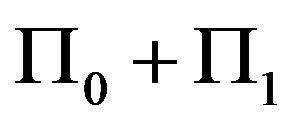 .
.
We investigate the game with the following orders of each firm’s moves: in the first stage, firms 0 and 1 simultaneously set their capacity levels. In the second stage, after both firms observe their capacity levels, they engage in quantity competition with each other.
3. Equilibrium Analysis
We solve the game by backward induction from the second stage to obtain a subgame perfect Nash equilibrium. In the second stage, firm 0 maximizes social welfare 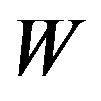 with respect to
with respect to , whereas firm 1 maximizes its payoff
, whereas firm 1 maximizes its payoff  with respect to
with respect to . The first-order conditions of firms 0 and 1 are, respectively, given as
. The first-order conditions of firms 0 and 1 are, respectively, given as
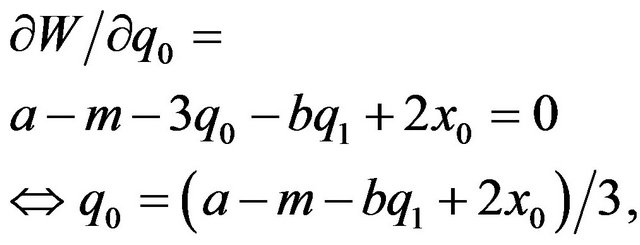 (1)
(1)
 (2)
(2)
yielding
 (3)
(3)
 (4)
(4)
In the first stage, both the firms know that their decisions regarding capacity affect their decisions regarding output in the second stage. Given Equations (3) and (4), firms 0 and 1 set simultaneously and independently their capacity levels with respect to social welfare and firm 1’s relative profit, respectively. Thus, by solving the firstorder conditions of firms 0 and 1, we have

yielding

Note that superscript * is used to represent the equilibrium outcomes of firms 0 and 1. Thus, the output levels of both firms in the equilibrium are given as follows:

Hence, from easy calculations, we obtain the following results on the difference between the output and capacity levels of both firms:
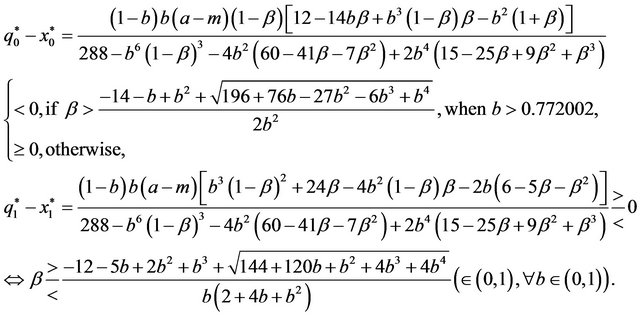
From the above calculations, the differences between the output levels and capacity levels between both firms 0 and 1 strictly depend on the degree of product differentiation and the degree of importance of firm 1’s relative performance. By summing these facts, we obtain the next proposition on the difference between the output and capacity levels of firms 0 and 1.
Proposition 1. Public firm 0 chooses under-capacity, 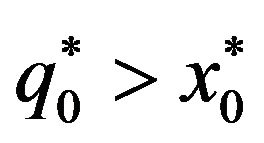 in the almost area of
in the almost area of 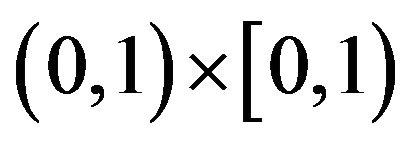 in the
in the 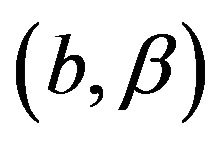 -plane on the degree of product differentiation
-plane on the degree of product differentiation  and the degree of importance of firm 1’s relative performance
and the degree of importance of firm 1’s relative performance  whereas it chooses over-capacity,
whereas it chooses over-capacity, 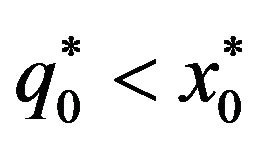 only when both
only when both  and
and  are sufficiently high. The difference between private firm 1’s output level and capacity level strictly also depends on both the degrees of product differentiation
are sufficiently high. The difference between private firm 1’s output level and capacity level strictly also depends on both the degrees of product differentiation  and of the importance of its relative performance
and of the importance of its relative performance . More precisely, private firm 1 selects under-capacity,
. More precisely, private firm 1 selects under-capacity, 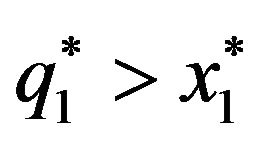 , if
, if  is high relative to b, whereas it selects over-capacity,
is high relative to b, whereas it selects over-capacity, 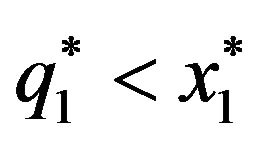 , otherwise. Moreover, the area in the
, otherwise. Moreover, the area in the  -plane where private firm 1 selects over-capacity widens as the value of the degree of product differentiation b increases.
-plane where private firm 1 selects over-capacity widens as the value of the degree of product differentiation b increases.
The intuition behind the result in Proposition 1 that public firm 0 chooses under-capacity, 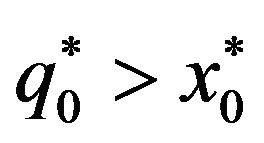 , except for the situation wherein both the degree of product differentiation b and the degree of firm 1’s relative performance
, except for the situation wherein both the degree of product differentiation b and the degree of firm 1’s relative performance  are sufficiently high is similar to that presented in Ogawa [8] who did not consider the degree of importance of the private firm’s relative performance. From Equation (4), we find that the capacity level of public firm 0 is negatively associated with the output level of the private firm 1. Thus, public firm 0 attempts to improve social welfare by reducing its capacity level and consequently inducing the aggressive behavior of the private firm. Therefore, public firm 0 selects under-capacity in the almost area of
are sufficiently high is similar to that presented in Ogawa [8] who did not consider the degree of importance of the private firm’s relative performance. From Equation (4), we find that the capacity level of public firm 0 is negatively associated with the output level of the private firm 1. Thus, public firm 0 attempts to improve social welfare by reducing its capacity level and consequently inducing the aggressive behavior of the private firm. Therefore, public firm 0 selects under-capacity in the almost area of  in the
in the 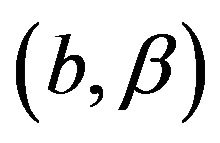 -plane on the degree of product differentiation
-plane on the degree of product differentiation  and the degree of importance of private firm 1’s relative performance.
and the degree of importance of private firm 1’s relative performance.
However, only when both the degree of product differentiation and the degree of importance of firm 1’s relative performance are sufficiently high, the difference of the output level and capacity level of firm 0 becomes reverse, and it chooses over-capacity, which is described in Figure 1. When the value of  is sufficiently high, from Equations (1) and (2), as the value of
is sufficiently high, from Equations (1) and (2), as the value of  increases, the degree of strategic substitutability between the outputs of both firms 0 and 1 further increases, and thus the output level of private firm 1 more sharply decreases if public firm 0 aggressively behaves in the market. In addition, from Equation (4), when the degree of importance of firm 1’s relative performance is sufficiently high and near 1, firm 0 is less likely to have an incentive to decrease its capacity level in order to increase the output
increases, the degree of strategic substitutability between the outputs of both firms 0 and 1 further increases, and thus the output level of private firm 1 more sharply decreases if public firm 0 aggressively behaves in the market. In addition, from Equation (4), when the degree of importance of firm 1’s relative performance is sufficiently high and near 1, firm 0 is less likely to have an incentive to decrease its capacity level in order to increase the output
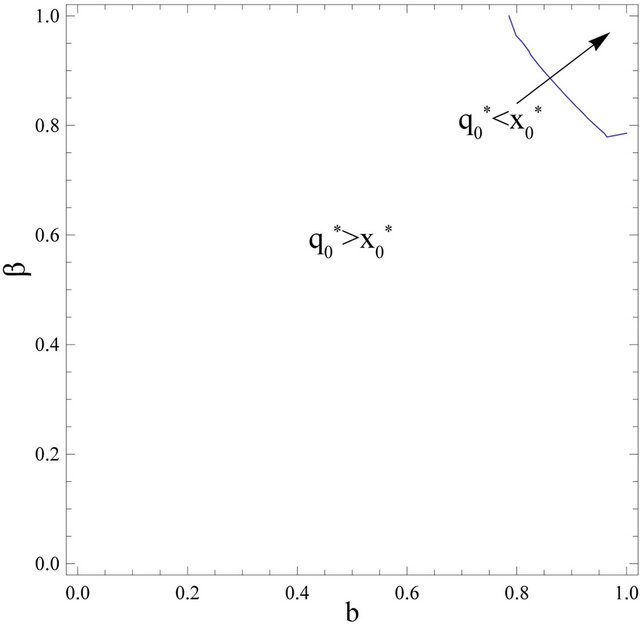
Figure 1. Difference of between firm 0’s output level and capacity level in the equilibrium.
level of firm 1, since the output level of firm 1 is almost independent of the capacity level of firm 0. Consequently, when both the degree of product differentiation  and the degree of importance of firm 1’s relative performance
and the degree of importance of firm 1’s relative performance  are sufficiently high, public firm 0 chooses over-capacity, which is different from that in Ogawa [8] that the degree of importance of the private firm’s relative performance is not taken into account.
are sufficiently high, public firm 0 chooses over-capacity, which is different from that in Ogawa [8] that the degree of importance of the private firm’s relative performance is not taken into account.
At the same time, Proposition 1 also gives that the private firm surprisingly chooses under-capacity when the degree of importance of its relative performance is high relative to the degree of product differentiation, which is described in Figure 2.13 We consider the two effects of the degree of importance of the private firm’s relative performance and of the degree of product differentiation on its output level and its capacity level. First, as the degree of importance of the private firm’s relative performance increases, it aggressively behaves in the market.14

Figure 2. Difference of between firm 1’s output level and capacity level in the equilibrium.
Thus, as the degree of importance of the private firm’s relative performance increases, its output level tends to rise. Second, from Equation (3), the private firm enlarges its market share through a decrease in the output level of the public firm by increasing its capacity level. Depending on which of the above two effects is relatively strong, the difference between the private firm’s output level and capacity level is determined. When the degree of importance of the private firm’s relative performance  is high relative to the degree of product differentiation
is high relative to the degree of product differentiation , the effect of
, the effect of  on the difference between its output level and its capacity level is consequently strong. Thus, the private firm strategically selects under-capacity. Otherwise, the effect of
on the difference between its output level and its capacity level is consequently strong. Thus, the private firm strategically selects under-capacity. Otherwise, the effect of  on the difference between the private firm’s output level and capacity level is comparatively strong. Thus, the private firm strategically chooses over-capacity in order to enlarge its market share through a decrease in the output level of the public firm by increasing its capacity level.
on the difference between the private firm’s output level and capacity level is comparatively strong. Thus, the private firm strategically chooses over-capacity in order to enlarge its market share through a decrease in the output level of the public firm by increasing its capacity level.
Finally, Proposition 1 provides the result that the area in the 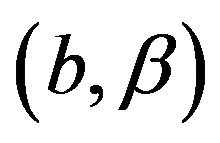 -plane wherein the private firm, firm 1, chooses over-capacity widens as the value of the degree of product differentiation
-plane wherein the private firm, firm 1, chooses over-capacity widens as the value of the degree of product differentiation  increases. This is so because the effect of the degree of product differentiation on the difference between the private firm’s output level and capacity level is comparatively strong relative to the effect of the degree of importance of the private firm’s relative performance.
increases. This is so because the effect of the degree of product differentiation on the difference between the private firm’s output level and capacity level is comparatively strong relative to the effect of the degree of importance of the private firm’s relative performance.
4. Conclusions
This paper investigated the difference between the output and capacity levels of both the public firm and the private firm in a quantity-setting mixed duopoly with differentiated goods, in particular when the objective function of the private firm is its relative profit. In the existing literature on the difference between the output and capacity levels of both the public firm and the private firm including Nishimori and Ogawa [7], Ogawa [8], Barcena-Ruiz and Garzon [9], Tomaru et al. [10], and so on, whether they select over-capacity or under-capacity depends on the degree of product differentiation, the style of market competition, and the presence of separation between ownership and management within the firms. In this paper, we showed that whether both the public firm and the private firm choose over-capacity or under-capacity strictly depends on the degree of importance of its relative performance. Furthermore, we found that under the assumption that the goods produced by the public firm and the private firm are substitutable, the signs of the differences between the output levels and capacity levels of both the public firm and the private firm change in accordance with the degree of importance of the private firm’s relative performance. More precisely, we showed that the public firm chooses undercapacity in the almost area of  -plane whereas it chooses over-capacity only when both
-plane whereas it chooses over-capacity only when both  and
and  are sufficiently high, and moreover the private firm can choose under-capacity when the degree of importance of its relative performance is high relative to the degree of product differentiation, whereas it can choose over-capacity otherwise. The over-capacity within the public firm results from (1) the difficulty of the strategically change of the output level of the private firm by manipulating its capacity level, which is led by the sufficiently high level of the degree of importance of the private firm’s relative performance, and (2) the intense strategic substitutability between the output levels of both the firms, which is led by the sufficiently high level of the degree of product differentiation. The under-capacity within the private firm is given by the fact that a relatively high level of the degree of importance of the private firm’s relative performance yields its aggressive behavior in the market.
are sufficiently high, and moreover the private firm can choose under-capacity when the degree of importance of its relative performance is high relative to the degree of product differentiation, whereas it can choose over-capacity otherwise. The over-capacity within the public firm results from (1) the difficulty of the strategically change of the output level of the private firm by manipulating its capacity level, which is led by the sufficiently high level of the degree of importance of the private firm’s relative performance, and (2) the intense strategic substitutability between the output levels of both the firms, which is led by the sufficiently high level of the degree of product differentiation. The under-capacity within the private firm is given by the fact that a relatively high level of the degree of importance of the private firm’s relative performance yields its aggressive behavior in the market.
Finally, we mention an issue to be tackled in the future. In this paper, we considered the differences between the output and capacity levels of both the public firm and the private firm in quantity-setting mixed duopolistic market. However, recent research on mixed oligopoly has been investigating the endogenous choice of the strategic variables of both the public firm and the private firm, and among them, Matsumura and Ogawa [34] showed that a price-setting competition is observed in equilibrium irrespective of whether the goods of both firms are substitutable or complementary. As indicated in Matsumura and Ogawa [34], this implies that the price-setting model should be used more in the analysis of mixed oligopoly. Thus, in the research on the capacity choices of both the public firm and the private firm in mixed duopoly, a price-setting competition should be adopted. Futhermore, throughout this paper, we employed the assumption that the inverse demand function of each firm’s goods is linear. If we drop such an assumption and consider more general inverse demand functions, in the model of this paper, whether the second-order condition for the maximization issue of the private firm is satisfied or not should be important. Thus, it is fruitful for us to explore (1) under what degree of general demand functions some analytical results can be obtained and (2) whether or not the results obtained under such a generalization on the inverse demand functions are consist with those obtained in this paper.15 Future research must deal with the above problems.
REFERENCES
- A. Dixit, “The Role of Investment in Entry Deterrence,” Economic Journal, Vol. 90, No. 357, 1980, pp. 95-106. doi:10.2307/2231658
- J. A. Brander and B. J. Spencer, “Strategic Commitment with R&D: The Symmetric Case,” Bell Journal of Economics, Vol. 14, No. 1, 1983, pp. 225-235. doi:10.2307/3003549
- Y. Horiba and S. Tsutsui, “International Duopoly, Tariff Policies and the Case of Free Trade,” Japanese Economic Review, Vol. 51, No. 2, 2000, pp. 207-220. doi:10.1111/1468-5876.00147
- G. Stewart, “Strategic Entry Interactions Involving Profit Maximizing and Labour-Managed Firms,” Oxford Economic Papers, Vol. 43, No. 4, 1991, pp. 570-583.
- J. Zhang, “Holding Excess Capacity to Deter Entry in a Labour-Managed Industry,” Canadian Journal of Economics, Vol. 26, No. 1, 1993, pp. 222-234. doi:10.2307/135855
- S. Haruna, “A Note on Holding Excess Capacity to Deter Entry in a Labour-Managed Industry,” Canadian Journal of Economics, Vol. 29, No. 2, 1996, pp. 493-499. doi:10.2307/136301
- A. Nishimori and H. Ogawa, “Do Firms Always Choose Excess Capacity?” Economics Bulletin, Vol. 12, No. 2, 2004, pp. 1-7.
- H. Ogawa, “Capacity Choice in the Mixed Duopoly with Product Differentiation,” Economics Bulletin, Vol. 12, No. 8, 2006, pp. 1-6.
- J. C. Bárcena-Ruiz and M. B. Garzón, “Capacity Choice in a Mixed Duopoly under Price Competition,” Economics Bulletin, Vol. 12, No. 26, 2007, pp. 1-7.
- Y. Tomaru, Y. Nakamura and M. Saito, “Capacity Choice in a Mixed Duopoly with Managerial Delegation,” Economics Bulletin, Vol. 29, No. 3, 2009, pp. 1904-1924.
- C. Fershtman and K. Judd, “Equilibrium Incentives in Oligopoly,” American Economic Review, Vol. 77, No. 5, 1987, pp. 927-940.
- S. D. Sklivas, “The Strategic Choice of Management Incentives,” RAND Journal of Economics, Vol. 18, No. 3, 1987, pp. 452-458. doi:10.2307/2555609
- J. Vickers, “Delegation and the Theory of the Firm,” Economic Journal, Vol. 95, No. 380, 1985, pp. 138-147. doi:10.2307/2232877
- Y. Lu and S. Poddar, “Mixed Oligopoly and the Choice of Capacity,” Research in Economics, Vol. 59, No. 4, 2005, pp. 365-374. doi:10.1016/j.rie.2005.09.004
- Y. Lu and S. Poddar, “The Choice of Capacity in Mixed Duopoly under Demand Uncertainty,” Manchester School, Vol. 74, No. 3, 2006, pp. 266-272. doi:10.1111/j.1467-9957.2006.00492.x
- Y. Lu and S. Poddar, “Endogenous Timing in a Mixed Duopoly and Private Duopoly—Capacity-Then-Quantity' Game,” Australian Economic Papers, Vol. 48, No. 2, 2009, pp. 138-150. doi:10.1111/j.1467-8454.2009.00369.x
- J. H. Hamilton and S. M. Slutsky, “Endogenous Timing in Duopoly Games: Stackelberg or Cournot Equilibria,” Games and Economic Behavior, Vol. 2, No. 1, 1990, pp. 29-46. doi:10.1016/0899-8256(90)90012-J
- J. C. Bárcena-Ruiz and M. B. Garzón, “Endogenous Timing in a Mixed Duopoly with Capacity Choice,” Manchester School, Vol. 78, No. 2, 2010, pp. 93-109. doi:10.1111/j.1467-9957.2009.02137.x
- T. Matsumura and N. Matsushima, “Competitiveness and Stability of Collusive Behavior,” Bulletin of Economic Research, Vol. 64, Suppl. S1, 2012, pp. 22-31. doi:10.1111/j.1467-8586.2012.00439.x
- F. Y. Edgeworth, “Mathematical Physics,” P. Kegan, London, 1881.
- R. M. Cyert and M. H. deGroot, “An Analysis of Cooperation and Learning in a Duopoly Context,” American Economic Review, Vol. 63, No. 1, 1973, pp. 24-37.
- T. Matsumura and M. Okamura, “Competition and Privatization Policy: The Relative Performance Approach,” mimeo, 2010.
- M. Kaneda and A. Matsui, “Do profit maximizers maximize profit? Divergence of Objective and Result in Oligopoly,” mimeo, University of Tokyo, 2005. http://www.amatsui.e.u-tokyo.ac.jp/profit50.pdf
- Y. Lu, “The Relative-Profit-Maximization Objective of Private Firms and Endogenous Timing in a Mixed Oligopoly,” Singapore Economic Review, Vol. 56, No. 2, 2011, pp. 203-213. doi:10.1142/S0217590811004201
- R. Gibbons and K. J. Murphy, “Relative Performance Evaluation for Chief Executive Officers,” Industrial and Labor Relations Review, Vol. 43, No. 3, 1990, pp. 30S- 51S. doi:10.2307/2523570
- A. A. Alchian, “Uncertainty, Evolution, and Economic Theory,” Journal of Political Economy, Vol. 57, 1950, pp. 211-221. doi:10.1086/256940
- F. Vega-Redondo, “The Evolution of Walrasian Behavior,” Econometrica, Vol. 65, No. 2, 1997, pp. 375-384. doi:10.2307/2171898
- J. C. Coats and W. S. Neilson, “Beliefs about Other-Regarding Preferences in a Sequential Public Goods Game,” Economic Inquiry, Vol. 43, 1973, pp. 614-622. doi:10.1093/ei/cbi042
- J.-J. Laffont and J. Tirole, “Competition in Telecommunications,” MIT Press, Cambridge, 2000.
- N. Singh and X. Vives, “Price and Quantity Competition in a Differentiated Duopoly,” RAND Journal of Economics, Vol. 15, 1984, pp. 546-554. doi:10.2307/2555525
- L. Kockesen, E. A. Ok and R. Sethi, “The Strategic Advantage of Negatively Interdependent Preferences,” Journal of Economic Theory, Vol. 92, No. 2, 2000, pp. 274- 299. doi:10.1006/jeth.1999.2587
- S. W. Joe, “Strategic Managerial Incentive Compensation in Japan: Relative Performance Evaluation and Product Market Collusion,” Review of Economics and Statistics, Vol. 81, No. 2, 1999, pp. 303-313. doi:10.1162/003465399558094
- X. Vives, “Commitment, Flexibility, and Market Outcomes,” International Journal of Industrial Organization, Vol. 4, No. 2, 1986, pp. 217-229. doi:10.1016/0167-7187(86)90032-9
- T. Matsumura and A. Ogawa, “Price versus Quantity in a Mixed Duopoly,” Economics Letters, Vol. 116, No. 2, 2012, pp. 174-177. doi:10.1016/j.econlet.2012.02.012
Appendix
Equilbrium Outcomes of Firms 0 and 1
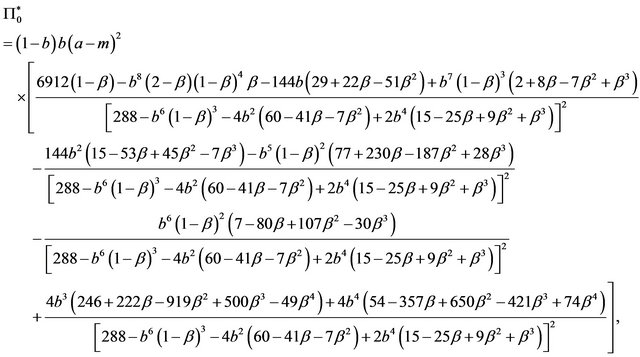


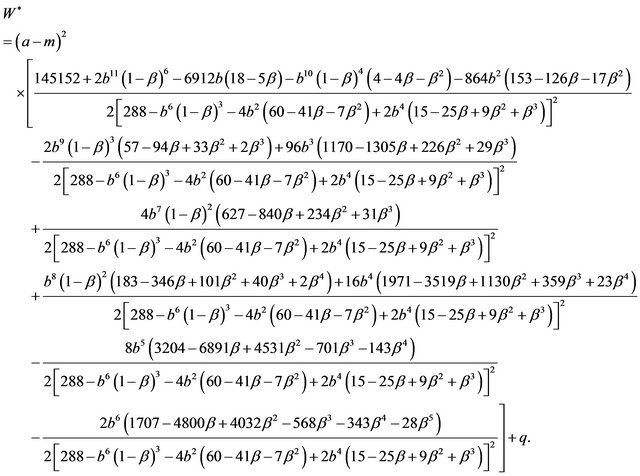
NOTES
*Nakamura thanks the financial support by KAKENHI (23730226).
#Corresponding author.
1After the seminal works of Dixit [1] and Brander and Spencer [2], Horiba and Tsutsui [3] investigated the effectiveness of the two types of tariff policies (discriminatory and uniform tariffs) in an international duopoly with each firm getting to choose its capacity level and output level. Moreover, Stewart [4], Zhang [5], and Haruna [6] considered the capacity choice of each firm in labor-managed industries.
2More precisely, in the context of mixed oligopoly, Nishimori and Ogawa [7], as the seminal work in this field, showed that the public firm chooses under-capacity while the private firm chooses over-capacity when the goods produced by both the public firm and the private firm are homogeneous. In mixed duopoly with differentiated goods, Ogawa [8] showed that in the context of quantity-setting competition, the public firm chooses under-capacity when the products are substitutes, and over-capacity when the products are complements, while the private firm chooses over-capacity irrespective of the relation of their products. Subsequently Barcena-Ruiz and Garzon [9] found that in the context of price-setting competition, the public firm chooses overcapacity when their products are substitutes and it chooses undercapacity when their products are complements, while the private firm chooses under-capacity irrespective of the relation of their products.
3As another strand of the literature on capacity choice in mixed oligopoly, Lu and Poddar [14] and Lu and Poddar [15] investigated the case of sequential moves and the case of demand uncertainty, respectively. Furthermore, in the context of quantity-setting competition, Lu and Poddar [16] considered a game with endogenous timing of the sequential choice of the capacities and quantities of both the public firm and the private firm on the basis of an observable delay game presented in Hamilton and Slutsky [17]. Subsequently, Barcena-Ruiz and Garzon [18] analyzed a game similar to that in Lu and Poddar [16] in the context of price-setting competition.
4In general, the analysis investigated in the context of private oligopoly adopted the assumption that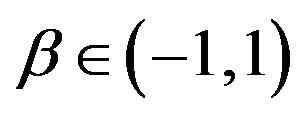 . As indicated in Matsumura and Matsushima [19], the parameter β is closely related to the “coefficient of effective sympathy” defined by Edgeworth [20], and the “coefficient of cooperation” defined by Cyert and deGroot [21]. As stated in Matsumura and Matsushima [19], in a private oligopolistic market, not only under a homogeneous-goods setting but also under a product differentiation setting, the equilibrium price of the goods produced by each firm decreases in β, and hence, an increase in β yields moreintense market competition. In addition, as indicated in Matsumura and Okamura [22] and in Section 3 of this paper, in a mixed oligopolistic market as well, a larger β implies a more-competitive market.
. As indicated in Matsumura and Matsushima [19], the parameter β is closely related to the “coefficient of effective sympathy” defined by Edgeworth [20], and the “coefficient of cooperation” defined by Cyert and deGroot [21]. As stated in Matsumura and Matsushima [19], in a private oligopolistic market, not only under a homogeneous-goods setting but also under a product differentiation setting, the equilibrium price of the goods produced by each firm decreases in β, and hence, an increase in β yields moreintense market competition. In addition, as indicated in Matsumura and Okamura [22] and in Section 3 of this paper, in a mixed oligopolistic market as well, a larger β implies a more-competitive market.
5In the typical existing literature on mixed oligopoly, it is supposed that the public firm maximizes social welfare whereas the private firm maximizes its pure profit. However, as indicated in Kaneda and Matsui [23] and Lu [24] and so on, in the context of the managerial theory, it has been long supposed that the private firm maximizes its relative profit rather than its pure profit in the real world economy. By adducing several real world instances, Kaneda and Matsui [23] and Gibbons and Murphy [25] empirically supported the advantage of the use of relative performance.
6See Alchian [26] and Vega-Redondo [27] as the works on such an evolutionary stability and see Coats and Neilson [28] and so on as the laboratory and experimental works.
9In this paper, we assume that the marginal costs of firms 0 and 1 are commonly denoted as . In addition, we assume that
. In addition, we assume that  in order to ensure the non-negativity of all equilibrium outcomes.
in order to ensure the non-negativity of all equilibrium outcomes.
10Throughout this paper, we restrict the interval of parameter  into
into  in order to ensure the non-negativity of all equilibrium outcomes, as with
in order to ensure the non-negativity of all equilibrium outcomes, as with 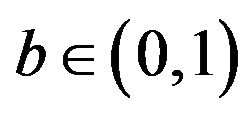 implying that the goods produced by both firms are substitutable.
implying that the goods produced by both firms are substitutable.
11Similar to Matsumura and Okamura [22], we regard social welfare as the sum of consumer surplus and the profits of firms 0 and 1 rather than the sum of consumer surplus and the relative profits of firms 0 and 1. Although firms’ CEOs emphasize their relative profit rather than their original profits because their relatively good performance increases current and future income, we consider that such an idea simply implies an income transfer. This is why we suppose that the social welfare in this paper is the sum of consumer surplus and the profits of firms 0 and 1.
12As indicated in Matsumura and Matsushima [19], if we adopt the sales delegation approach in Fershtman and Judd [11], Sklivas [12], and Vickers [13] and replace each firm’s sales with the (negative) profit of the opponent firm in their model, the firms would use a positive value of β. Moreover, see the works of Kockesen et al. [31] and Joe [32] for detailed discussions on stories and empirical results presenting views in support of both the positive and negative values of β.
13In the context of price competition, in a mixed duopoly, if the goods of both the firms are substitutable, Barcena-Ruiz and Garzon [9] showed that the public firm can strategically choose over-capacity whereas the private firm can choose under-capacity. Subsequently, Tomaru et al. [10] found that both the public firm and the private firm can choose under-capacity by introducing managerial delegation with separation between ownership and management in the fashion of Fershtman and Judd [11], Sklivas [12], and Vickers [13]. However, there does not exist any literature in this field wherein the result that the differences between the output levels and capacity levels can reverse signs according to the degree of product differentiation under the assumption that the relation between the goods of the public firm and the private firm are restricted to the case of substitutability, is obtained. The main contribution of this paper is that even if the goods of both firms are substitutable, both the public firm and the private firm can strategically change the signs of differences between their output levels and their capacity levels.
14In fact, in cases wherein 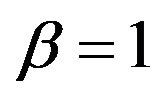 and the goods produced by both the public firm and the private firm are homogeneous,
and the goods produced by both the public firm and the private firm are homogeneous,  , the firm whose objective function is its relative profit sets its output level such that the market price coincides with its marginal cost, which is the same behavior as in the situation wherein the same firm is a pricetaker.
, the firm whose objective function is its relative profit sets its output level such that the market price coincides with its marginal cost, which is the same behavior as in the situation wherein the same firm is a pricetaker.
15We deeply thank the anonymous referee for suggesting this interesting analysis.

